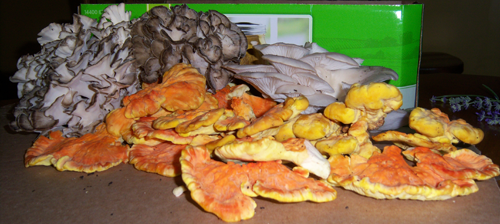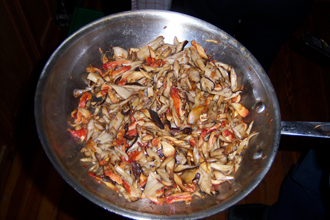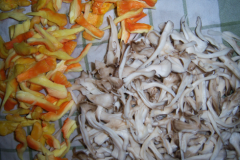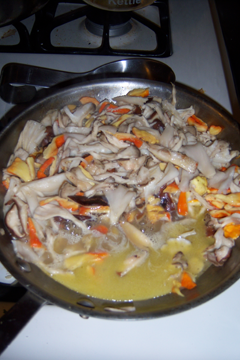Mushroom Hunting Season Maitake, Oyster, Sulfur Shelf, 2011
Mushroom hunting season is in full swing in the northern states for some of my very favorites. Yes as much as I love morels as a harbinger if spring, for the thrill of the hunt, and for their delicious nutty flavor, a much larger variety of mushrooms emerges in the late summer fall. Many rival the morel for flavor, a number have important medicinal qualities, and a lot of them tend to be easier to find. Take the ‘sulfur shelf‘ (Laetiporus sulphureus) or ‘chicken of the woods’ for instance. You can see clusters of this bright yellow and orange mushroom growing on fallen logs and the sides of trees from a quarter mile away.

the other day I found maitake (left rear), sulfur shelf (front), and oyster (right rear) mushrooms all within a 100 yard section woods near Lansing, Michigan
Perhaps my favorite of all, the ‘Maitake‘ (Grifola frondosa) or ‘hen of the woods’ (not to be confused with ‘chicken of the woods’) can grow to be as big as a bushel basket and weigh several pounds. Maitake mushrooms are found around the base of oak trees, and are often prolific around dying oaks. It is valued for its medicinal properties (studies have shown that it can lower blood pressure and cholesterol levels, help to prevent the growth and spread of cancer cells, boost the body’s immune system, among other things) but it is also delicious. Both maitake and sulfur shelf are ‘polypores’, meaning that their underside has pores instead of gills, from which they release their spores. Another favorite, often found on downed logs, or growing on the sides of trees is the Oyster Mushroom (Pleurotus species). It can come in a multitude of colors from white to grey, to yellow, or even blueish. Unlike the sulfur shelf or the maitake, these mushrooms have gills, and aren’t quite as distinctive, meaning there are some other mushrooms that can look a little bit like them like them. With any mushroom, it is essential to be 100% sure of what you have before eating it, since many can be poisonous, even deadly. But with a little research and effort, you can learn to identify many choice edible species on sight. And the rewards can be significant. Many mild mushrooms are far more flavorful, delicate, and have more interesting and satisfying texture than the button mushrooms which, until recently were basically the only kind of mushroom you could find in commercial supermarkets and even health food stores and co-ops.

a finished pan of maitake, sulfur shelf, and oyster mushrooms (fresh from the woods) with a few store bought shiitake's I didn't want to waste thrown in. DELICIOUS!
The best place to look for a variety of fall mushrooms is in a mature mixed hardwood, or hardwood/conifer forest. Be sure you know the area, or bring a compass so you don’t get lost, wear long pants and good hiking boots because you need to get off the path if you really want to find what’s choice, and carry a basket or mesh bag so that you spread the spores of what you pick as you’re walking around. Local mushroom hunting groups or clubs exist in many areas, so look/ask around since this can often be the best way to learn. Also check out the many resources and recommended books on mushrooms on our Mushroom Production Page, the bottom of which has information on collecting wild mushrooms.
When preparing wild mushrooms for eating, especially the larger ones described above, I cut off any really dirty or tough parts (with polypores, the edges are typically the most tender and best for cooking) then slice or break them into bite sized pieces, and wash them in a colander to remove any excess dirt, then dry them on a towel.
The simplest way to cook them to really bring out their flavor and texture is simply to fry them in a pan with a tablespoon or so of butter or olive oil (I like to use butter). I also add salt as they begin to heat. this draws out the moisture, and let them cook until the juices have evaporated and they are even a little bit crispy in places, and not slimy which is what many people don’t like about the texture of mushrooms. But they don’t have to be that way. It just takes a little patience. Be careful not to burn them, but cooking them down will give you a nice texture without the mushiness or slimness many people associate with mushrooms (see the finished pan above). Hope some of you will get out there and enjoy the bounty!
-Taylor





 Your Privacy Choices
Your Privacy Choices
The best producing hen of the woods tree in maine is located at the Spirit Pond Preserve Phippsburg land trust trails in Phippsburg maine.
the coordinates are approximately: 43.751511, -69.807439
Spirit Pond Hen Of The Woods Red Oak Tree Map Link:
https://goo.gl/maps/xav2jNiw9u82
every single year this ancient red oak produces at least 50 pounds of prime grade A hen of the woods, maitake, grifola frondosa, g. frondosa mushrooms! Hen of the woods seems to be independent of drought conditions. Though after years of hen hunting, I have only found hen-of-the-woods mushrooms within 200 feet of water, whether that be salt water or fresh water, or brackish water. Often times the old oaks where they are found are immediately on the edge (even overhanging) of a body of water, and frequently near tidal areas along the coast of maine.
The Spirit Pond oak tree produces from the middle of September to the middle of October every single year, and has done so for at least the last 15 years and probably longer. The tree is located toward the beginning of the spirit pond trail and about 200 feet from spirit pond at the site of an old homestead and near the spirit pond burial ground. the tree fell directly over a portion of the trail in 2015 but still grows hen of the woods mushroom from the remaining stump, around the stump and from the base of the fallen tree itself in huge numbers and size. Check this tree frequently during the season as it is well known locally to grow hens.
Where to find the second most productive hen of the woods oak tree in maine is at the Center Pond Phippsburg land trust trail in Phippsburg maine. It is located at the edge of center pond just opposite the beaver pond along the main trail.
Center Pond Phippsburg Maine Hen of the Woods Map Link
https://goo.gl/maps/6RM8cur8mio
43.809922, -69.815736
The preceding geo-location in this instance is exact. The fallen trunk of this tree can be seen on google maps satellite view. This grifola frondosa supporting red oak tree has grown mushrooms as late as mid November and particularly on, and inside the hollow portion of the fallen tip-over dead section.
The hen of the woods that this tree produces range from 10 – 20 pounds. this tree is easily accessed and well known, so the maitake go quickly.
Fantastic information. Thanks for the tip. Happy grifola hunting.
There is a large, very ancient oak off the Denny Reed trail on a steep hillside in Phippsburg Maine that produces large amounts of hen of the woods mushrooms every year.
Location:
Basin Preserve Hatch Rd, Phippsburg, ME 43.796459, -69.857000
https://www.google.com/maps/place/43%C2%B047'47.3%22N+69%C2%B051'25.2%22W/@43.796469,-69.8575532,200m/data=!3m2!1e3!4b1!4m13!1m6!3m5!1s0x4cad82abae046579:0xa204b6d878bf5850!2sDenny+Reed+Trail+Head!8m2!3d43.7957864!4d-69.8574787!3m5!1s0x0:0x0!7e2!8m2!3d43.7964677!4d-69.8570059?hl=en